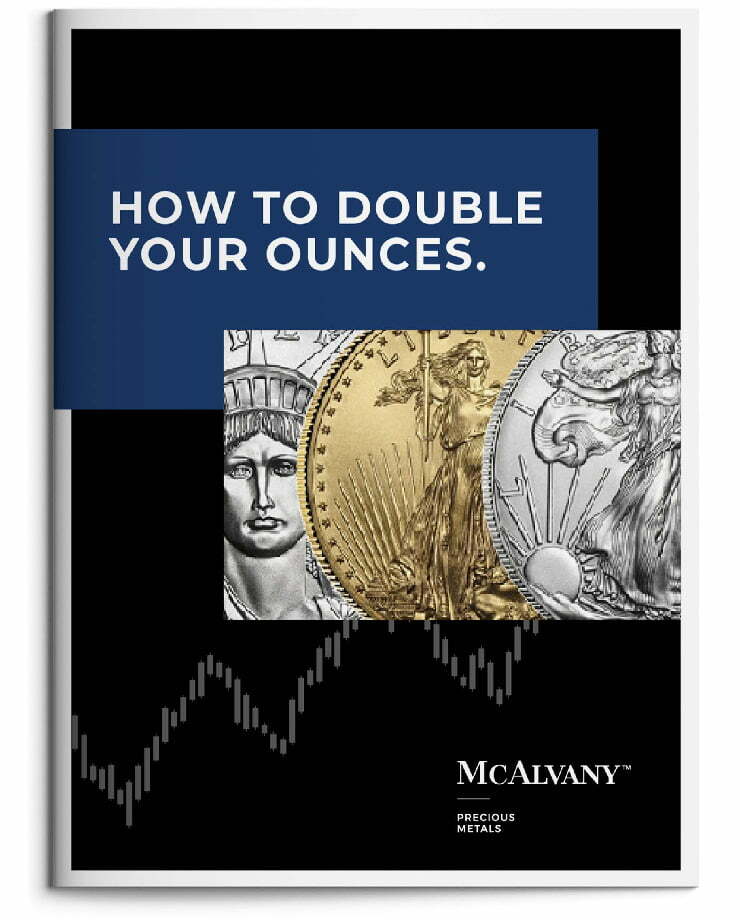Podcast: Play in new window
- First Brands & Tricolor Failures Signal Future Disaster
- Financing Government Debt Now More Important Than Price Stability
- Register For The Next Regime Playbook Webinar
“Certainly, we are dealing with what economists describe as a K-shaped economy. The wealthy have everything and it’s going up and to the right. And the less well-off are down and to the right.
“You can see the K-shape in asset prices. If you own them, you’re up and to the right. If you don’t own anything, your balance sheet is down and to the right. You see it in income disparity, percentage of the gross national income—boom, up and to the right for the wealthy, down and to the right for those who are kind of stuck in their job and unable to move. The effects of inflation, who is it really felt by—down and to the right versus up and to the right?” – David McAlvany
* * *
Kevin: Welcome to the McAlvany Weekly Commentary. I’m Kevin Orrick, along with David McAlvany.
David, Doug Noland is going to be talking Thursday for the Tactical Short. I’d like to encourage all of our listeners to tune in.
David: Yeah, in fact, we have two Thursdays coming up. That’s this Thursday for the Tactical Short call. Before we get started, I wanted to briefly mention an upcoming event from our team at McAlvany Wealth Management. Thursday, November 13th, 10:00 AM Mountain Time, we’ll be hosting a live webinar titled, “The Next Regime Playbook.”
And we’ll have a 90-minute briefing focused on structural shifts taking place in the global economy, changes in policy, changes in debt, inflation, resource markets, and things that are reshaping how investors need to think about the decade ahead. I’ll be joined by Morgan Lewis and Philip Wortman as we discuss what’s unfolding in the markets, and I think the positioning that we recommend in the new environment will be very critical for investors to tune into.
You can register using the link in the show notes. If you cannot attend live, we’ll send the replay and materials after, for all that register. So again, that’s Thursday, November 13th, 10:00 AM Mountain, and that’s “The Next Regime Playbook.”
Kevin: Okay. Yeah, and I’m looking forward to that because I was there live when McAlvany Wealth Management had a very similar review on the bubble dynamics that we have going on right now. And this one is just specifically for anyone who wants to listen, not just McAlvany Wealth Management investors.
David: I think just introducing a broader group of investors to the core McAlvany Wealth Management framework and our current market outlook. And it extends the same research and themes that we shared in a recent client conference. So monetary and policy regime changes, debt monetization, inflation as policy, the end of the petrodollar, global capital flows, and central bank gold demand, shifts in the energy landscape.
Again, that’s November 13th, and mark your calendars for this week, Thursday. This week, Doug and I will take our quarterly discussion of market liquidity, market fragility and market participant zeal. I use the word zeal because the fervent nature of capital allocation these days is based more on the unseen than the seen—faith and fervor.
Kevin: So artificial intelligence, the invisibility of it and all the things that it creates.
David: Exactly. It’s the faith and fervor tied to this transformational thing called AI. Missing from the narrative are the energy production and grid capacity limits, direct household competition for energy. So people are facing increased costs to heat their home or to cool it in the summertime as we’re dealing with the limitation in energy.
So narratives feed on themselves and it’s like the centrifugal energy of a whirling dervish. This week, I was reminded of momentum and its continued progress and then also its limits. We were in Moab, Utah with several families. It’s a biannual trip for all of us. 15 years in a row, we’ve done this with five families. We go out in the spring, go out in the fall and just have a blast.
Kevin: You guys have the best time. I know— I heard your son talking about it on Friday before you guys left, but isn’t running down sand dunes one of the things that you guys like to do?
David: One of the traditions is heading to a giant sand dune just across the way from Arches National Park, and we climb to the top, and eventually there is a race to the bottom, and all is well till speed becomes destabilizing and bodies start flying end over end. A few of us volunteer to document the event with a camera. I would be in that group.
Kevin: You guys should do that. I’d like to see that, but I think I know where you’re going because you’re talking to Doug right now, and the credit cycle is something that has so much momentum right now, but it looks like it may be at the end.
David: Yeah, I think credit will of course be a feature on this Thursday’s call. Credit cycles have a beginning, they have a middle, and they have an end. Several recent revelations—we’ll cover them in brief today—support this being the end of a credit cycle, not unlike the involuntary cartwheel that happens on the sand dune, credit cycles always start well, but also usually end poorly.
Kevin: Sand is a soft landing though, Dave. This is not a soft landing you’re talking about.
David: Well, risk increases with velocity, and credit expansion plays an important role in not only the velocity of money but the velocity of asset appreciation. There’s a direct energy source for asset bubble dynamics that comes from the credit markets.
Kevin: We just came from a meeting with Morgan Lewis. Every Tuesday we meet with him, and he could not express to us over and over and over— He just could not get through to us that this is— Every one of these bubble dynamics is hitting highs. I mean, even the Shiller PE right now is at 41. What did we get to back in 1999?
David: 43.
Kevin: Okay, so we’re close.
David: Yeah, we’re very close. And of course that blew out as earnings began to drop, but prices were sticky to the upside. So again, sort of numerator/denominator effects. Thursday— And actually I’ve asked Doug to join us on the Commentary next week to explore some of these themes in greater detail, and we’ll look at the magical combination of a powerful narrative like AI coupled with massive liquidity in the financial markets, which elevates stocks to prices and valuations that are not sustainable.
I mean, ultimately, prices need to be supported by a positive return on investment. I know that sounds simple, but too few investors today have their feet planted on the firm ground of a positive rate of investment, ROI. And as we talked about last week, you have trillion dollars of market capitalization amongst your 10 best AI names. The biggest AI names, not a single one of them have revenue.
Kevin: They’re not bringing in any money.
David: There is no ROI.
Kevin: They’re sucking energy and they’re sucking profits.
David: If you follow the narrative, eventually it’ll change everything. I think bubble dynamics are interesting. I see it almost every day as I review portfolios for investors with accounts from a variety of Wall Street firms. Nobody wants to get out.
Kevin: Well, it’s addictive, Dave, but also there’s tax. A lot of times, people will make decisions based on the fact that they owe a tax on the gain.
David: Yeah, there is the greed aspect of making money and wanting it to continue just a little bit longer. And there is admittedly a rush, a biochemical engagement, making lots of money as momentum picks up and price velocity increases, it feels good.
Kevin: There’s endorphins.
David: But you’re right, there’s also the fear and loathing of taxes, and I can’t tell you how many times the tax tail has wagged the dog for clients, whether it is forestalling the payment of capital gains or sometimes they’ll embrace complex tax structures that promise and indeed do typically deliver lower taxes. People fixate on giving up a portion to Uncle Sam, and they often allow the gains to slip away as market momentum shifts and fades—as they will with prices.
Kevin: Well, and sometimes it turns into a tax loss, not a tax gain, and that’s, like you said, wagging the dog. That tail can really be damaging if you don’t have a discipline for when to get out.
David: There’s an aspect to money management that letting your profits run is important, but all assets run in cycles—both short-term and long-term cycles. Having processes and disciplines are key. Buying has a set of disciplines, so does selling. It’s one of the reasons we like ratios, because prices can confuse the decisions in front of an investor, and relative value often clarifies the appropriate next step.
Kevin: What do you think, Dave, about some of the black boxes that they build to try to manage taxes? I’ve seen sometimes those black boxes actually manage the buying and selling decisions at the wrong time.
David: Well, again, for those intent on complex structures for tax reduction, the legal and accounting costs of maintaining those complex structures typically suck away most if not all of the tax savings. CRTs come to mind. Charitable Remainder Trusts. I can’t tell you the number of times I’ve seen future decisions changed and altered by the constraints put on the structure itself and the cost to maintain—again, from a CPA standpoint, from a legal standpoint. Every year those recurring costs are there as long as the entity exists and ultimately catch up and exceed the tax savings.
Kevin: So it’s pretty costly. But what would you recommend? I mean, you’re not a tax person necessarily.
David: No. Just never let the tax tail wag the dog. You’ve got to gain, take it. I mean, one cost-effective strategy, which most major brokerages offer is called a DAF. D-A-F stands for Donor Advised Fund. You can shift highly appreciated assets into a DAF, which allows for full tax deduction with an extended time frame then for charitable giving thereafter. That’s not a fit for everybody, but if a portion of your funds are earmarked for giving and not for personal use, a DAF can be an amazing tool. It doesn’t have the complex structure of a CRT or things like that, and it does allow for considerable control thereafter, particularly if it’s at scale.
Kevin: Dave, there seems to be a policy shift, pretty pronounced right now, that it doesn’t matter what kind of inflation rate we face, they’re going to cut rates. It’s already priced into the markets that we’re going to see lower interest rates in a period of time where we really should be raising interest rates.
David: Yeah, the argument is that financial conditions are very tight. That’s what we’ve heard over and over again from the Federal Reserve, and yet we see corporate credit spreads the narrowest in 25 years. We see asset prices and equities, all-time highs. Real estate very close to that. You’re right, market expectations are for a cut to fed funds both this month and throughout the next year as well.
Kevin: That’s inflationary.
David: Currently priced in 109 basis points in total by next year this time. What’s interesting is that the Taylor Rule, which assumes an equilibrium fed funds rate of 2% above the annual inflation rate, it would suggest the Fed’s next move should be higher, not lower. 5.5%, 6% should be the fed fund’s rate. We shouldn’t be moving in the direction of 3. We should be raising not lowering interest rates.
Kevin: And you’re actually saying exactly what John Taylor said. The Federal Reserve pays homage to John Taylor and they act like they really appreciate his work. But the truth of the matter is they’re lowering rates when John Taylor’s rule would say that you need to raise them. He was a guest of yours here on the Commentary. What was that, about a decade ago?
David: Right now he’s being conveniently ignored. The recent CPI print provides some cover for Powell to announce a lowering of rates. If inflation is going away, then perhaps we should lower rates.
But looking at the most recent CPI print, you had a very strange, sort of anomalous, calculation with owner equivalent rent. That’s how they count housing inflation. And so, that brought it down considerably. That’s the largest line item in the CPI metrics. And then the fact that 40% of price data was uncollected in September due to the government shutdown. I don’t think I’d be running any victory laps over the 3% year-over-year inflation rate. Wouldn’t run them just yet. Financing government debt, that is a top priority. You see that from Bessent. You see that from the White House.
They know that the interest component is way too high, and so bringing rates lower, that is their effort. I suspect that inflation will surprise in 2026, and the Fed’s credibility could be very much at risk. But what has become a priority even greater than price stability is financing government debt. Again, an expression of credibility loss with our central bank is likely to be seen in the currency market as the next leg lower in the US dollar.
Kevin: So, this is very similar to the big oven where it just consumes the house. It warms the house to start with, and then it consumes the house. Because if government debt is the main goal of being able to finance that, and it takes us into a high inflation, I mean, look at housing costs right now. Stock market, all-time highs. I mean crypto this year, we saw all-time highs. Look at gold.
David: This amount of liquidity is anything but a market that is constrained by higher rates. The tight financial conditions that the Fed has kept at the tip of their tongue, equity markets that are at all-time highs. Housing remains near its highs, although volumes are suggestive of pricing pressure. Cryptos have traded to fresh all-time highs as recently as September. I see a host of new ETF offerings that we went from two times leverage to three times leverage. Now, there’s a number of ETFs that are offering five times leverage to the underlying asset. Some of those are individual companies. Yeah, I mean, again, it’s like an options call, but it’s structured in the form of an ETF.
Kevin: But we talked about two weeks ago—the margin call. Margin calls can kill you.
David: Yeah, we’ve also noted that margin debt is over $1.1 trillion, up 39% year-over-year. Markets are super liquid. Risk appetite is at an extreme. And as we said, financial markets are incredibly loose, not tight. Lowering rates feeds those bubble dynamics. I mean, we’re talking about in asset markets, which of course everyone loves a bubble on the way up—
Kevin: Sure.
David: —but it is increasingly risky as time goes on. The risks associated with equities have not been this high for a long time.
Kevin: Right. So, Dave, I think I know the obvious answer to this, but what would you say is the action item when you’re in a market like this, frothy?
David: I think the action item is to raise cash. And so, you trim a position. Speculative energy is of course supported by liquidity dynamics, but the credit markets are dealing with fresh concerns that may well drain that liquidity and leave investors subject to a nasty reversal.
So, if you’re not sure, if you’re not sure, take out your original cost basis and let the rest ride. If you feel like you still want equity exposure in the broader markets, the Nasdaq-100, the S&P 500, just trim back your position, leave the proceeds from those sales in cash. If the market does reverse lower, you’re already in a strong position.
Kevin: That’s called playing with the house money. You take your original investment off the table and you play with house money.
David: And then you have the luxury of making measured cuts to your portfolio from there. Most people delay until they are overwhelmed by the losses that are accruing or the gains that they gave up, and they’re hoping then for a recovery in value. And they do nothing until they reach a pain point which is too great and then liquidate at lows.
So, again, just raise cash, take out your original investment. If you’ve done well with an equity position, be grateful that you’ve ridden one of the greatest bull markets in history.
Kevin: And again, I have to smile because Morgan is a very calm individual as he talks about economic numbers. But I could tell emotionally he was trying to convey something very, very emotional. He says, “Do you realize just how overvalued we are in these markets?” And so the stress level—for a person who understands history and understands economics—is very high, but it’s not showing up in the credit markets. It’s not showing up in the bond market right now.
David: Well, as we often comment, this bull market is a bull market in nominal terms. And so, to see the Dow and the S&P and the Nasdaq at these levels is remarkable in nominal terms, but it’s actually quite disappointing priced in real money.
Kevin: Priced in gold.
David: Priced in gold, the last 25 years have accrued to a 60% to 75% loss. It’s about 75% loss relative to gold.
Kevin: Brokers don’t like to hear that.
David: No. If the market does reverse lower, you’re already in a strong position. Just be proactive in raising cash. Corporate credit spreads, they still suggest little to no stress in the bond market, except we have had two significant failures which are changing the tone in the private credit markets and the least liquid expression of junk debt. If you want to think about the private credit markets, it is junk. It is very high yield.
Kevin: Very hard to sell.
David: It’s even higher yield than what you would find in the junk bond market, in the high-yield market. So, lower quality, less liquidity, and that’s where we’re beginning to see at least a couple of cockroaches. So, first, brand’s failure and then Tricolor’s failure a few weeks ago continues to raise concerns in the structured finance market. If these concerns are not ameliorated in short order, it’s reasonable to assume bond market stress is next—high yield and then ultimately investment grade debt. If you look at the Bloomberg Leveraged Loan Index, it registered its first loss since April, with the default rate quadrupling over the past two years according to Bloomberg.
Kevin: That’s the part that most people don’t see is the default rate, until it hits them.
David: Well, and again, you’re talking about the leveraged loan index. Who’s invested in leveraged loans? These are institutions, these are insurance companies, these are pension funds. This is not something that someone goes on to CNBC and says, “I wonder how the leveraged loan market is doing today? I wonder how the CLO market is doing today?”
Kevin: Well, you don’t necessarily sell a leveraged loan to somebody. It basically gets placed into a captive audience, like you said, an insurance company.
David: Now, interestingly, there are some new ETF products that allow you to buy highly liquid CLOs and leveraged loan products. It’s becoming popular, but that’s what happens at the end of a cycle. I remember talking to one of our friends on the East Coast many years ago, this was 2008, 2009. He was very excited about the reduction in barrier to entry to hedge funds. Instead of it being a million dollars—
Kevin: Now you can play.
David: With $50,000 and democratizing access to financial products suggests that the best days are already behind you, and the folks on Wall Street now need new players just to keep—
Kevin: New bag holders.
David: Exactly. You got to keep the game going. You got to keep volumes flowing. And so, the little guy does end up being the bag holder. One of your first indications that that’s coming is products accessible to the general public never before accessible. It’s a democratization of access. And I mean, you can hear from the White House, they’re talking about giving access to 401(k)s, where you can own private credit in your 401(k).
Kevin: Put your bag that nobody wants to hold in your 401(k). But you talked about it. It first starts with junk bonds, and then it moves to regular investment grade, doesn’t it?
David: Yeah, there is a notable tone change in the leveraged loan and the collateralized loan obligation space with unexpected corporate failures becoming more expected. It’s happening more regularly, and portfolio managers are selling distressed debtor paper in response to credit downgrades, and it’s happening fairly routinely in the last three to six weeks. This is the periphery of the credit markets, and where you’d expect to find the problems. No one should treat them as surprises. I mean last week it was the second in a row of outflows from U.S junk bond mutual funds. So, there are growing concerns even amongst the hoi polloi, if you will, a change in tone and now a change in flows.
I think this is worth thinking about, a change in tone and now a change in flows. ETFs, I mentioned ETFs for collateralized loan obligations, CLOs also saw outflows last week. The issue with those structures is in the implied liquidity provided by an ETF. How easy is it to sell? Go online, click the mouse, you’re done. But the underlying assets are not that liquid. So, where do they go? Who is the next buyer who makes a market in private credit in CLOs, weekly inflows into CLO ETFs? They’ve averaged—this is the inflow—they’ve averaged 421 million year to date. That’s the weekly inflows. Last week was a $516 million outflow.
Kevin: That would be considered a reversal. So, last week, you talked about the IMF—
David: Change in tone, change in flows, worth keeping in mind. The credit markets at the periphery are beginning to show a little stress.
Kevin: Well, and you brought it up last week because the shadow banking— Okay, now there’s a fancy name for that. It’s non-bank financial institutions.
David: NBFIs.
Kevin: There you go, but it’s shadow banking.
David: It’s shadow banking. So, we highlighted the IMF’s review of financial market concerns, including the crossover of liabilities between commercial banks and the NBFIs last week. You get US and European commercial banks—combined, US and European—with an estimated $4.5 trillion exposure—that’s with a T—to shadow banks, which far exceeds what Reuters has documented as a $300 billion exposure in US bank loans to private credit providers. So, there’s—
Kevin: Four and a half trillion.
David: Part of what the IMF paper was getting at is, we don’t have our arms around how big this is. Is it what Reuters reports, a $300 billion exposure? Is it, when you look at the US and European market combined, four and a half trillion dollars exposure? There’s a big gap between 300 billion and four and a half trillion.
Kevin: Well, and we compared it to an iceberg last week. Okay, and I know that can be a tired metaphor, but 300 billion would be the top. Everything underneath, that 4.2 trillion, would be underneath.
David: Yeah, Reuters calculates the percentage of total bank loans to the non-bank financial institutions currently at 10.4% of their entire loan book. So, it’s not an insignificant percentage, and that’s up from 3.6% a decade ago. This has been the largest area of loan growth in US commercial banks since 2016. Every year since 2016, that’s where they’ve been making loans. It’s basically, we can’t go to the general public, but we can keep a tranche of risk on our balance sheet. And then, through these structured products, move them on, but still participate.
The jitters. The jitters are entering the conference and the boardrooms following First Brands—that’s the auto parts manufacturer that went bankrupt—and Tricolor, which is a subprime auto lender. They declared bankruptcy out of the blue.
Kevin: So, I want to bring something up that I remember, Dave, when we were doing the Commentary back during the global financial crisis, going all the way back to 2008, 2009. Moody’s and Standard and Poor’s, the rating services, were giving everybody high marks as they went on to fail. There was a mea culpa there where it’s like, “What’s going on?”
David: Well, and essentially what they were doing is this slicing and dicing of financial products-
Kevin: Right.
David: —and if you can create tranches of risk, you can take one and say, “Well, this is triple A over here because it’s very limited in its risk and we’ve carved it out from the rest. This other stuff may be just absolute toxic waste, but it’s not a part of this product.” Now, they are connected because the underlying assets—
Kevin: Pay no attention to the other part of the asset behind the curtain.
David: Right.
Kevin: Right.
David: But in a very similar fashion, if you look at real estate law, you can have any bundle of sticks. And when you own real estate, do you own one or do you own all of the sticks?
Do you own the water rights? That’s one stick. Do you own the surface rights? Do you own the mineral rights? You may own a piece, but not the whole. And that’s what they’ve deliberately done to a particular asset class. When they go through this structured financial process, they’re slicing and dicing. That’s the IMF concern.
So, not unique to an end-of-cycle dynamic is the accounting and audit work done for these firms and these particular products, which is there to confirm legitimacy and the viability of the books. And this happened just weeks before the failure of both First Brands and Tricolor.
BDO—unfortunate. BDO signed off on First Brands financials weeks before several billion dollars simply vanished. And the reason why I say this is end of cycle, that’s the best way to frame it, is because the tide reverses and the naked swimmers are revealed. Tide goes out and there you are in your birthday suit.
Kevin: Yeah, but this goes back to the IMF report. I mean, it’s not just the IMF right now that has been saying, “There’s a problem here.” The Bank of International Settlements has also been screaming.
David: Yeah. In a three week period you’ve got the IMF, the BIS, and the Bank of England all raising concerns over private credit and the slicing and dicing of risk tranches.
Kevin: Right.
David: As you’ve said before, bodies are buried in many of your insurance company portfolios. Like a moth to the flame, for years now insurance companies have gravitated to higher yielding paper.
Kevin: Well, haven’t they had to? I mean, we went through that period of time where we were zero interest rates. How did an insurance company continue to pay?
David: Right. A part of it does relate to being in a zero interest rate environment and searching for better alternatives. You’ve got to match up your future liabilities with an income stream, and in a zero interest rate environment it forces you to take more risk, but you’re not really concerned about it because you can hold those assets to maturity.
Kevin: Right.
David: So regardless of the ups and downs of market volatility, you don’t have to mark them to market, and so you are in this unique carved out space—
Kevin: As long as they don’t default.
David: Well, that’s right. And because insurance companies don’t have the equivalent of depositors, the captive asset portfolios at insurance companies have been prime targets for private equity and private credit. Right?
So this is again, where these groups get to dump their trash. Bloomberg counts the insurance total assets, if you’re looking at the global insurance market, 23 trillion. 23 trillion in assets. And the intent of these insurance companies is to continue to add to private market holdings. The effort is to smooth long-term returns.
They don’t want to see the volatility in the stock market and the bond market, so they have these structured products which have the guaranteed rate of double digit returns. And you can take on a little bit more illiquidity because again, you don’t have a depositor base that’s going to come knocking and say, “I want my money back,” like you would at a bank.
So, in a BlackRock survey of 463 insurance company executives, 93% expect to increase their exposure to private equity and private credit. Only 3% said that they were considering reducing their exposure.
Insurance companies already hold two and a half trillion dollars in private credit assets, 250 billion in CLOs. If you want to know where the next major bailout will have to be, look at insurance companies. Look at the annuity powerhouses.
When I say that’s where the bodies are buried, we’re talking about mass graves. Regulatory arbitrage, that’s the game. You can do, inside insurance companies, what is impermissible in more scrutinized and regulated markets.
Kevin: Well, and up to this point, insurance companies typically bail each other out, but this could be larger than that.
David: Well, insurance companies are quickly becoming a version of shadow banks. This is what will come as a surprise to the markets. “It’s a black swan event. I can’t believe this insurance company went under.” You can’t claim this as a black swan event. This setup was laid out.
The Federal Reserve was writing about the risks of insurance companies becoming shadow banks as far back as 2023. This is not a news flash. It just takes time for rot to fester.
Kevin: I wonder, because one of the things that the insurance companies have avoided is a lot of government regulation because they self-regulate. They bail themselves out, and it’s worked. I mean, even look at the depression, the insurance companies came through the depression because they saved each other. But right now, for competitive reasons, like you said, it’s becoming a shadow banking system on its own.
David: I think it’s also that you have individual state regulators for insurance companies.
Kevin: Right.
David: So, what is the law of the land in California may not be the law of the land in Nebraska, Idaho, or Florida. And so it allows for a dance to take place. That’s the regulatory arbitrage that private equity and private credit are taking advantage of in order to be able to place their wares into these portfolios and then to walk away.
Well, not just walk away because, frankly, some of the private equity groups have bought insurance companies specifically to be able to feed their products continually. Capture that captive asset and just— They’ve got a place, “Do you need to raise money?” “No, I bought an insurance company.”
Kevin: It’s a symbiotic relationship, isn’t it? Yeah, just feed it on out. It’s the trash pile.
David: Axios describes institutional investors this way. And again, this is all in the wake of these two company failures. And you might not have even heard of these two company failures, but the ripple effects into the credit markets—
Again, it’s creating some consternation around boardroom tables, and asset allocation committees are having to say, “We need to get our arms around the risks that we have in the portfolio.” And Axios said, “There is a rush to risk discovery.”
And again, following the blowups of First Brands and Tricolor, there is a question on the table. And it’s amazing to ask this question after—after, keep this in mind in the sequence, after—engaging in complex and illiquid assets.
Kevin: Well, and then after—
David: What do we own?
Kevin: —after these guys got good ratings right before they failed. The rating industry is basically saying, “Hey, you guys are fine.”
David: So, what do we own, and what is our downside risk from here? Add to that the professional asset allocator that takes on accounting firms’, any accounting firm’s, word for legitimate financials only to discover a clean bill of health from an auditor is worthless. It’s the equivalent of financial and accounting malpractice.
Kevin: And we saw that during the global financial crisis.
David: Well, even before that. Enron was the end of Arthur Anderson. And I think this is really the critical piece here. Trust breaking down is a really important social signal that you are at the end of a cycle. Prices follow.
Kevin: We saw that with the silver show a couple of weeks ago, all the stress in the silver market. I was laying in bed thinking, “Okay, what’s the bigger meaning of this?” when the lease rate went to 200%. The bigger meaning is that trust is breaking down worldwide. When you’re charging somebody 200% interest, it means you don’t trust them. I mean, let’s face it.
David: Yeah. I mean there’s aspects of that for sure. To be clear, we’re not talking about black swans within the credit market. We’re talking about broken risk management and so much liquidity sloshing around the system that fiduciary standards are compromised in order to stay competitive. And that’s your investment banks, that is loan covenants, that is what we just described, accounting malpractice.
Kevin: Well, and we talked about the 1987 crash was actually caused by the very thing that was supposed to ensure that it wouldn’t happen. I mean, we’re talking about insurance companies here. Insurance companies are supposed to be able to pay off when you need them, right?, not taking speculative risk.
David: Yeah. And that’s not to say all insurance companies are in the same boat. When you look at your mutuals, they are owned by shareholders, basically the folks that have contracts with the insurance company. You are, as a mutual policyholder, an owner of the business, and there’s a lot less risks taken with—
Kevin: Spreads the risk. Yeah.
David: That’s exactly right. But I mean, they’re also not accountable to shareholders on a quarterly basis for an improvement in returns. So the performance metrics are different, the risk calculus is therefore significantly different, and so if you’re hearing me say there is something toxic in insurance company balance sheets, that’s true.
The carve out is mutuals. That’s the carve out. Most of the time they are run very conservatively for the benefit of the policy holders. Not if the company is publicly traded.
Kevin: It’s not a race to performance.
David: That’s right.
Kevin: Well, things have changed quite a bit over the 38 years that I’ve been here, Dave, and actually, since we started the commentary, because we talk a lot about artificial intelligence being in some respects smarter than the average Joe, okay, on different things. But we’ve got these quant funds right now that are making almost completely autonomous decisions with no human interaction. Tell us about that.
David: Well, the human interaction is on the front end, the design, the algorithms, the if-then scenarios, and the understood relationships between asset classes.
Kevin: It’s like a Rube Goldberg machine, you build it and you put the—
David: For trading money.
Kevin: Yeah.
David: Yeah, and so you find a lot of, one of the famous quant funds was Long-Term Capital Management, and you’ve got established relationships. If the relationships break, then the leverage that you had in the portfolio can hurt you very badly. We almost lost the financial system in 1998.
Kevin: Right.
David: There are other signs of stress under the market’s calm veneer. Going back to last week’s comments, quant funds are losing money in October. A number of the biggest ones, with some notable $10 and $20 billion funds down between 11 and 15%.
Kevin: So the brilliance of these quant funds, I’m like, “Okay, open the pod bay door, HAL, open the pod bay doors. You’re not doing well. I need to get my money out.”
David: So the quants, along with the long/short funds, are under pressure, which raises the odds of a deleveraging cascade. Highly leveraged and they’re trading massive amounts of money for a few pennies gain here and there.
Kevin: Right, and they’re automated.
David: Largely automated.
Kevin: Yeah.
David: And October month to date gains in the Goldman Sachs Most Short Index, 21%. 37% over the last six weeks. 122% off of the April market lows. Now, if you’ve got companies that are reasonable to short because they’re just poorly run companies, they have terrible management, terrible assets, they’re not making any money, they’re on their way out the door, like going the way of the dodo, there is a logic to shorting them. But it’s those companies that are up 21% month to date, 36, 37% in the last six weeks.
Kevin: You can get caught with your shorts down. Yeah.
David: Well, and hedge funds now control over five trillion in assets. That’s a new record. And more than a few of those are impacted by these low-quality companies ripping higher on forced covering of shorts. That has the lasting effect of reducing market hedges at a point where hedging is entirely justified.
And we did talk about this a few weeks ago in terms of our hedging of inventory and the hedge all of a sudden becoming the greatest risk to us. We managed it well, we’re well past that, but it’s ironic that again, downside protected positions can be the risk.
Kevin: Right. And you had to go cover those hedges another way because the 200% was too much.
David: Yeah. So signs of market dysfunction abound. And usually signs of market dysfunction are in the vicinity of market dislocation. Right now we’ve got the peripheral credit market stress which is either resolved quickly or it spreads to the core of the credit markets.
And if the credit market issues, if that again emerges closer to the core, then you’re talking about equity markets being in their final days of advancement, final period of advancement. Till then, nothing to worry about.
Kevin: Right.
David: Flows are positive. Global equity flows increased by 11.03 billion last week. That’s global equities. US equities saw inflows of 9.65 billion. That’s fresh inflows in a week. There’s plenty of liquidity. Markets are moving higher. It’s just these subtle things that are suggestive of stress, and they may come to nothing. On the other hand, it was two small funds, I think they amounted to 400 million, with an M. Can you imagine such a pedestrian number? A million.
Kevin: Why worry?
David: And this was sort of 2006 when those hedge funds went under, and that set in motion the global financial crisis, an unwind of significant risk. And all of a sudden counterparty exposures and slicing and dicing and creative financing—you found that actually the interconnections and the daisy chain-like interconnections within the financial market were terminal in nature.
Kevin: Well, and you used the term, million. I remember Bear Stearns, we talked about it when Bear Stearns came out. They had some really garbage debt that they wanted to sell. Or was it garbage assets? I don’t know what you call it when it can’t be sold and it’s not worth anything.
But they tried to sell 400 million into the markets of what you’re talking about, and nobody wanted it. And when you’re talking about assessing risk, all of a sudden, the boardrooms that you’re talking about assessing risk, they started saying, “Okay, there’s a problem.” And it was the greatest global financial crisis that we had been through since the Great Depression.
David: Yeah, so just refresh a couple of those numbers, 250 billion of CLOs in insurance company portfolios. 2.5 trillion of private credit embedded in insurance company portfolios. I mean, it’s—
Kevin: It’s a bomb waiting to go off.
David: It’s junk debt, high yield with no liquidity. “No” is probably an exaggeration. Limited liquidity. And under the worst circumstances, no liquidity. You remember Jim Deeds was on our program probably 15 years ago, and Jim recalled a scenario where he went into his brokerage house and there was the mail room, which was completely filled, floor to ceiling with—
Kevin: With municipal bonds.
David: —municipal bonds.
Kevin: That could not be sold.
David: This is when stocks and bonds actually had a certificate, a piece of paper, attached to them. It wasn’t just digital ones and zeros to prove ownership. There was no market for them. Everybody was on a waiting list. If you want to sell your munis, get in line. That’s obviously not the market dynamic today with municipal bonds. But we are talking about much higher risk and much less liquid assets within the private markets.
Kevin: So Dave, a question on everyone’s mind right now with the government shutdown in effect, how are US Treasuries doing? Are we able to sell our treasuries at this point?
David: Well, you’d think with the government shutdown, maybe government spending was slowing because there’s less people showing up for work and less of the wheels of government turning. Well, on a brighter note, the Treasury market remains healthy, even as we sail past 38 trillion in debt. 38 trillion.
Kevin: Wow. We’re still adding debt while we’re closed.
David: We passed 37 trillion in mid-August. Again, coming back to that topic earlier, the cartwheel down the sand pile, velocity, anyone?
Kevin: Velocity is increasing.
David: We are picking up speed in terms of debt. It seems that peripheral credit market concerns are actually causing some ripples here, and aiding in a reduction of Treasury yields. So people are looking and saying, “There’s some risk. Maybe I want to own some Treasuries.” They are top of the food chain in the debt markets, but it’s worth pondering. Powell’s latest move to a very dovish tone may well reflect his concerns with credit issues spreading to the core.
Certainly we are dealing with what economists describe as a K-shaped economy, and that has its focus. The wealthy have everything and it’s going up and to the right. And the less well-off are down and to the right. That’s the K-shape that economists often or occasionally refer to. You can see the K-shape in asset prices. If you own them, you’re up and to the right.
If you don’t own anything, your balance sheet is down and to the right. You see it in income disparity, percentage of the gross national income—boom, up and to the right for the wealthy, down and to the right for those who are stuck in their job and unable to move. The effects of inflation, who is it really felt by—down and to the right versus up and to the right?
And of course, you see with this K-shape the discontent of the mass— And this is not just in the United States, but there’s a K-shaped economy developing globally, and it shows up as more radical political views.
Kevin: Well, and healthy economics always means healthy middle class. And when you don’t have a middle class, you just have the rich and the poor. It makes me think of the black horse in the book of Revelation. You’ve got the poor who are being very much affected by famine, but it says, “Do not harm the oil and the wine.” Now, I don’t want to say I understand fully what that means, but the oil and the wine probably has something to do with the rich. And so that separation between rich and poor, that can really create political tensions.
David: I do think that you’re talking about an end-of-cycle dynamic where these extremes are so much more blatant, sort of robber baron-esque. We talk about a trillion dollar pay package for Elon Musk, a trillion dollar compensation package for one man. Again, this is classic K-shape. There is the rich of the rich of the rich and the poor of the poor of the poor. And it is a defining factor in politics, in geopolitics, and ultimately I think the discontent shows up within the financial markets.
Kevin: So let’s close with talking a little bit about the, let’s see, we don’t want to call it a correction on gold. Robert Draper today said, “Let’s don’t call anything like that a correction.”
David: A cooling.
Kevin: Let’s call it a cool down. So this cool down that we have on gold and silver right now, what are your thoughts?
David: Well, the market’s been hot. I looked back, and it was basically less than a two-month stretch and gold moved a $1,000 an ounce. That’s a lot, very fast. And for it to cool off—thank you, Robert—for it to cool off would be expected, normal. And I was able to do an interview with one podcaster in the Southeast, Curtis Bowers, and we talked a lot about being patient and being opportunistic about your purchases in the metals.
We don’t know where the low is in this cyclical cooling off because you have price insensitive buyers in the market. It could be today. So dollar cost averaging into a position, taking an amount that you want to invest and dividing it into thirds, I think makes sense. If you’re looking at the metals as a vital allocation going forward with none of the fundamentals having shifted—in fact, they are worse by the day; just count the 38 trillion we sailed past.
Kevin: Well, and Morgan just said just a few minutes ago before we came into the studio, he said, “If you think gold is too high,” he said, “It’s not nearly high enough.” He said, “Whatever the correction or cool down is, it’s not nearly high enough.”
David: It’s not nearly high enough. And we’ve talked about technical aspects of that with a cup and handle in the breakout and seven- to eight-fold move off of the 1,050 lows set back in December of 2015. That pencils out at seven to eight thousand dollar gold price. I don’t think that’s unrealistic.
Being opportunistic about your additions to positions or even initiating a fresh position, you’ve got an opportunity. And I think it’s worth paying attention to. One of the reasons why we’re confident in the direction of gold, you’ll discover that joining us on Thursday, November 13th, “The Next Regime Playbook.”
If you don’t understand the regime change which is afoot, you won’t know how to invest appropriately.
Kevin: That’s historic.
David: You won’t know how to mitigate risk appropriately, and between Morgan and Philip and myself, we’ll look it through the unfolding market risks and opportunities, and see what the ideal or optimal allocation is in the current market environment.
Kevin: Well, look forward to listening to that.
* * *
You’ve been listening to the McAlvany Weekly Commentary. I’m Kevin Orrick, along with David McAlvany. You can find us at mcalvany.com or you can call us at (800) 525-9556.
This has been the McAlvany Weekly Commentary. The views expressed should not be considered to be a solicitation or a recommendation for your investment portfolio. You should consult a professional financial advisor to assess your suitability for risk and investment. Join us again next week for a new edition of the McAlvany Weekly Commentary.
















